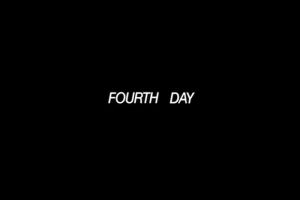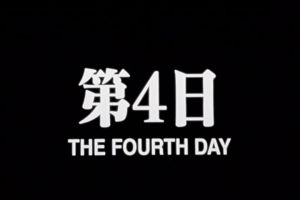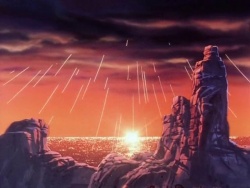Tributes to Other Fiction in Neon Genesis Evangelion: Difference between revisions
UrsusArctos (talk | contribs) mNo edit summary |
UrsusArctos (talk | contribs) No edit summary |
||
| Line 107: | Line 107: | ||
===Space Runaway Ideon=== | ===Space Runaway Ideon=== | ||
[[Image:Ideon 8 souls raining into ocean.jpg|250px| Souls fall towards Earth's oceans]] | [[Image:Ideon 8 souls raining into ocean.jpg|250px| Souls fall towards Earth's oceans]] | ||
| Line 150: | Line 150: | ||
Perhaps the most well-known science fiction tribute in the series, Seele's black monoliths are taken from Stanley Kubrick's classic 1968 film, ''2001: A Space Odyssey''. | Perhaps the most well-known science fiction tribute in the series, Seele's black monoliths are taken from Stanley Kubrick's classic 1968 film, ''2001: A Space Odyssey''. | ||
[[Image:2001 monolith1.jpg|thumb|left|]] | [[Image:2001 monolith1.jpg|thumb|left|]] | ||
[[Image:2001 monolith2.jpg|thumb|none|An accurate portrayal of Evangelion and its fans.]] [[Image:Also_Sprach_Zarathustra1.jpg|thumb| | [[Image:2001 monolith2.jpg|thumb|none|An accurate portrayal of Evangelion and its fans.]] | ||
===The Sun, Earth and Moon in alignment=== | |||
A shot that originates from 2001: A Space Odyssey and is used again in "spiritual predecessor" Ideon and once again in Evangelion. | |||
[[Image:Also_Sprach_Zarathustra1.jpg|thumb|left|250px|2001: Thus spoke Zarathustra]] | |||
[[Image:Ideon_5_sun_earth_moon.jpg|250px|thumb|center|The Sun, Earth and Moon at the end of Ideon]] | |||
===The Andromeda Strain=== | ===The Andromeda Strain=== | ||
Revision as of 01:35, 15 March 2008
As the title says, this page is for listing references or tributes to other shows found in evangelion.
Earlier works by Gainax
Otaku no Video
The date of Second Impact, September 13th, comes from Otaku no Video (おたくのビデオ), a 1991 pseudo-documentary anime about the history of Studio Gainax and Japanese otaku in general: Otaku no Video in turn took the date and the backstory of the nuclear disaster from Gerry Anderson's classic 1975 science fiction series Space: 1999. Evangelion simply changed the year from 1999 to 2000.
Throughout Otaku no Video, placards with dates of (more or less) important world events are used to mark the frequent time skips in the show. The following translations of the placards are from AnimEigo's DVD subtitles:
- March 18, 1982: Broadcast Premiere of "Magical Princess Minky Momo."
- May 1, 1982: British Troops invade the Falkland Islands.
- February 10, 1983: Six 16-year-old boys commit repeated assaults on homeless persons in Yokohama, killing 3 and injuring 13.
- September 1, 1983: A Korean Airlines jet is shot down by a Soviet plane.
- October 13, 1983: Court reaches verdict in the Lockheed-Marubeni bribery scandal.
- October 13, 1983: Ex-Prime Minister Kakuei Tanaka is sentenced to 4 years in prison.
- July 7, 1984: Theatrical Premiere of "Super Dimension Fortress MACROSS: Love--Do You Remember?"
- March 7, 1987: Theatrical Premiere of "The Royal Space Force (Wings of Honneamise)."
- July 23, 1988: Self-Defense Forces submarine "Nadashio" and fishing boat "Dai-ichi Fuji Maru" collide and sink in Yokosuka Bay. 30 fatalities.
- January 18, 1989: The Showa Emperor dies, ushering in the "Heisei" era.
- September 13, 1999: An accidental explosion occurs at the Nuclear Waste Disposal Facility on the far side of the Moon.
- May 5, 2035: Launching of "Eltrium," 5th-Generation Space Battleship.
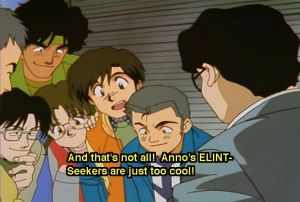
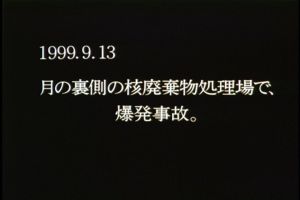
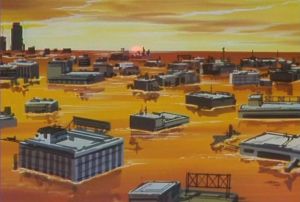
In the epilogue set in 2035 Tokyo has been flooded by raising sea levels, much like in Evangelion. Battleship Eltrium is a reference to Gunbuster. Other references to earlier works by Gainax staff include snippets of Daicon IV opening animation and Hideaki Anno's key animation sequences from Super Dimension Fortress Macross. A comprehensive list of the references can be found in AnimEigo's liner notes.
The Orphan Conversation (Nadia and Kare Kano)
Hideaki Anno has made multiple uses of what has been dubbed, the "Orphan Conversation". Which always ends with some variation on "we're the same".
From Nadia: The Secret of Blue Water (Anno's series before Evangelion):
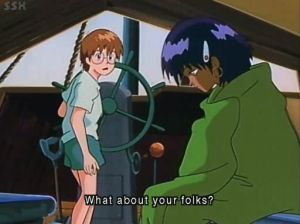
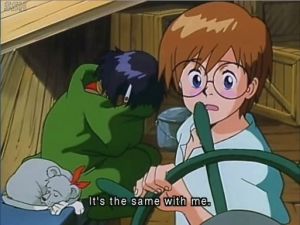
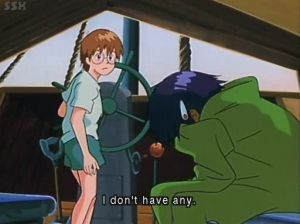
(Jean and Nadia have just escaped from the Grandis Gang and are traveling down river by boat.)
Jean: "Where will you go now? Back to the circus?"
Nadia: "I can't go back."
Jean: "What about your folks?"
Nadia: "I don't have any."
Jean: "I see. It's the same with me."
From Neon Genesis Evangelion:
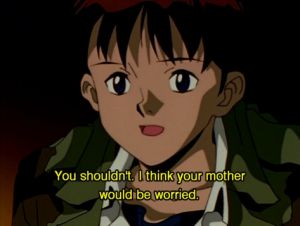
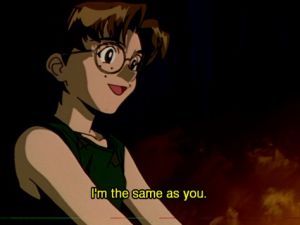
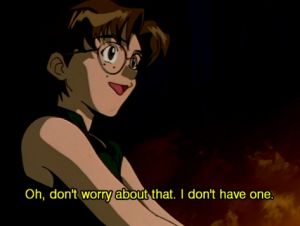
(Shinji has met Kensuke in the wilderness.)
Kensuke: "I really envy you. Living with such a beautiful woman and getting to pilot Evangelion. Oh, I wish I could get behind the controls just once!"
Shinji: "You'd better not. Your mother would be worried."
Kensuke: "Ah, that's okay. I don't have one."
Shinji: "Ah…"
Kensuke: "I'm the same as you, Ikari."
From Kareshi Kanojo no Jijo, aka Kare Kano, aka His and Hers Circumstances (Anno's series after Evangelion):
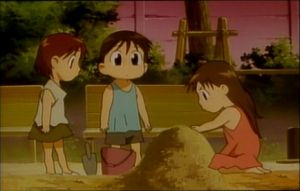
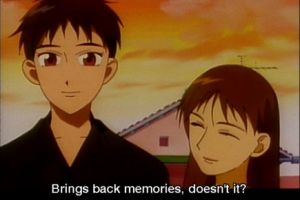
(Yukino's parents, Hiroyuki and Miyako pass by three children in a sandbox with the ubiquitous pail and shovel.)
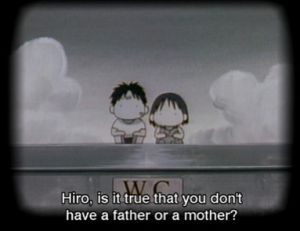
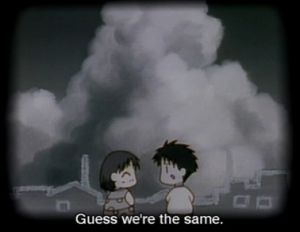
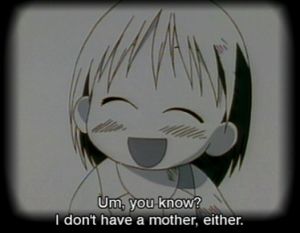
(In a flashback episode about Yukino's parents' courtship, Hiroyuki and Miyako are hiding on top of a public restroom while playing hide and seek.)
Miyako: "Hey, Hiro."
Hiroyuki: "Yeah?"
Miyako: "Hiro, is it true that you don't have a father or mother?"
Hiroyuki: "Yeah, that's right."
Miyako: "Um, you know? I don't have a mother either. Guess were the same."
Hiroyuki: "The same?"
Other anime and manga
Detonator Orgun
Detonator Orgun is a three-episode OAV from 1991. While it's impossible to tell for certain whether or not it actually influenced the creators of Evangelion, there are a number of similarities that are worth noticing, even if they are entirely coincidental:
The main character Tomoru synchronizes with a sentient alien bio-mecha; however, it is later revealed that the "aliens" are, in fact, not aliens at all, but super-evolved humans. The final episode features shamelessly overblown biblical symbolism, most notably in the form of Orgun's Grand Cruciform final attack. Smaller visual details include a naked girl floating in a tube, and a couple of Gendo Poses.
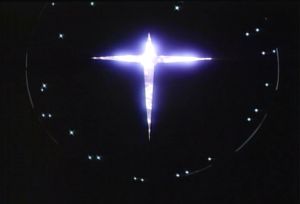
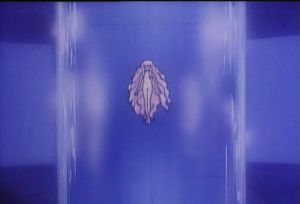
My Neighbor Totoro
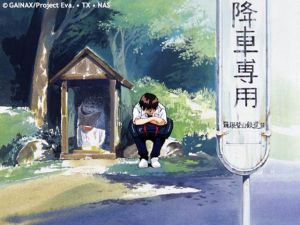
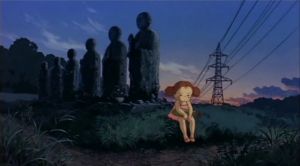
In Episode 04, after exiting the bus, Shinji rests by a statue of Jizo-san, the patron deity of travelers and children. This shot is apparently a tribute to a similar shot from Miyazaki's My Neighbor Totoro.
Oniisama E
In Episode 18, a scene from the Shoujo classic Oniisama E aka Brother Dear Brother is reconstructed almost shot-by-shot. First they establish that two close friends are chatting in a park.
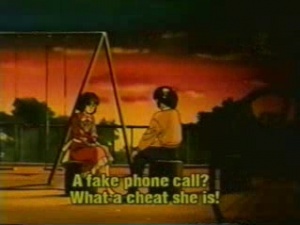
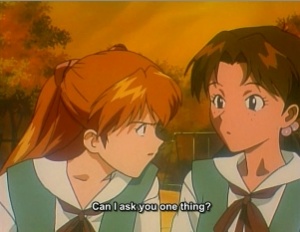
Then there is a lingering shot of their feet...
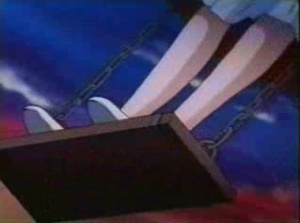
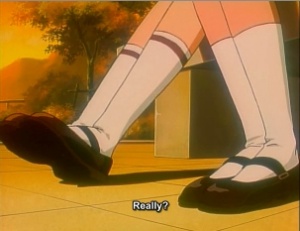
and then a shot of a nearby sandbox including a pail and shovel.
The cast of Oniisama E also includes characters named "Rei Asaka" aka "Hana no Saint Juste" (Saint Juste of the Flowers), and "Kaworu Orihara" aka "Kaworu no Kimi" (Prince Kaworu).
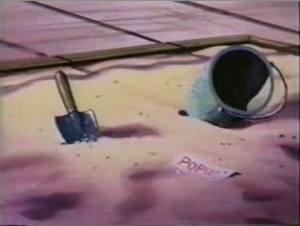
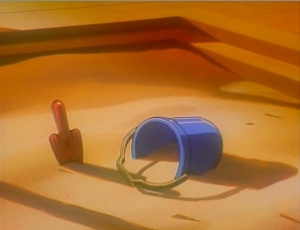
Space Runaway Ideon
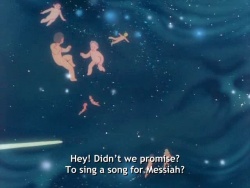

- Singing happy bithday to the children...the origins of the Evangelion use of the word "children" for the Eva pilots and a forerunner of the "congratulations" ending scene.
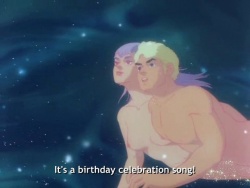
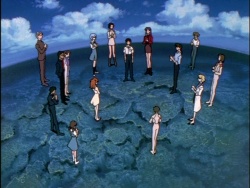
The Super Dimension Fortress Macross
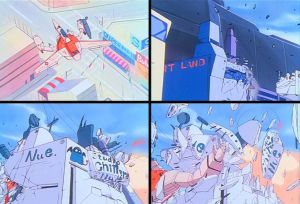
The Super Dimension Fortress Macross is a classic mecha anime that aired on October 3rd, 1982, and started a franchise of TV Series, OVAs, and Movies. It was directed by Noboru Ishiguro and featured unique mech designs that were based on the Grumman F-14 Tomcat. Hideaki Anno was a key animator on this project (see Otaku no Video).
In the first episode, the protagonist Hikaru Ichijo inadvertently ends up piloting and crash-landing a variable fighter, destroying in the process the offices of Artland and Studio Nue, the companies that created Macross. In Episode 09 of Evangelion, Asuka's Eva-02 leaps on and demolishes the half-submerged building of Studio Fantasia, one of the animation studios involved in the production of NGE.
- The genetic similarity between Humans and Zentradi
(pending)
Visual Motif: Blue Octahedrons (Nadia, Laputa and 2001)
The Fifth Angel Ramiel is shaped like a gigantic blue crystal octahedron. This shape could be a reference to a number of things:
- The Blue Water Crystal from Nadia: The Secret of Blue Water is a blue octahedron, although more elongated in shape than Ramiel.
- Hayao Miyazaki's 1986 movie Laputa: Castle in the Sky features a flying castle, which is powered by a similarly shaped blue crystal.
- Also, the "Star Gate" sequence in the movie 2001: A Space Odyssey features different kinds of psychedelic shapes and forms, including pulsating objects which momentarily look very Ramiel-like.
However, since an octahedron is not a terribly complex geometric shape, it is just as likely that all these similarities are simply unintentional coincidences. For all we know, the inspiration for Ramiel's design might have just as well come from a common salt crystal.
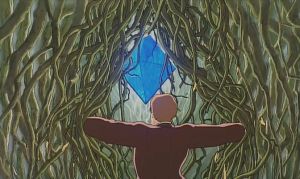

Other
2001: A Space Odyssey
Perhaps the most well-known science fiction tribute in the series, Seele's black monoliths are taken from Stanley Kubrick's classic 1968 film, 2001: A Space Odyssey.
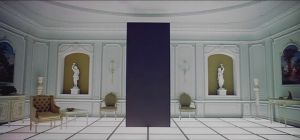
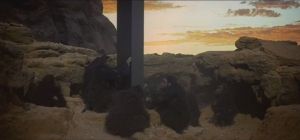
The Sun, Earth and Moon in alignment
A shot that originates from 2001: A Space Odyssey and is used again in "spiritual predecessor" Ideon and once again in Evangelion.
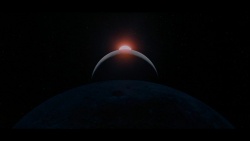
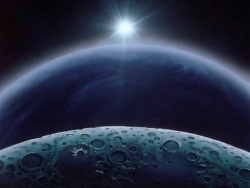
The Andromeda Strain
(This list details some of the more notable references to Wise's 1971 movie version of The Andromeda Strain. As the movie is a very loyal adaptation of Crichton's original novel, the thematic and plotline similarities between the book and Evangelion Episode 13 are largely present in it as well and are not repeated here. Most of these findings originate from the Evangelion Mailing List FAQ (although they never had screenshots), so once solid referencing guidelines are in place, we must give credit where credit is due.)
- Interrupted call
Dr. Stone has been hauled away from his home by some "army types with guns". His wife Allison is distressed and tries to call her father who is a senator.
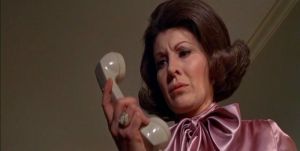
- Allison: You tell the senator it's his daughter!
- Senator: Allison?
- Allison: Dad, something very peculiar has just happened, even for Jeremy. A few minutes ago...
- (Phone begins to beep.)
- Allison: Dad, are you there? What's going on?
- Female voice: This communication is being monitored. The connection has been broken for reasons of national security. You will be briefed at the appropriate time. Thank you for your cooperation, Mrs. Stone.
In Episode 19 (Platinum subtitles):
- Kensuke: Are you there, Shinji? Is it true that you're leaving? It's true, isn't it? But why? Why are you running away now? I wanted to be like you. I envied you. You're different from us. Damn! Even Toji became an Eva pilot, while I...
- (Phone beeps.)
- Female voice: This line is monitored. For security reasons, we have terminated this call. We appreciate your cooperation.
- Flashes in the sky
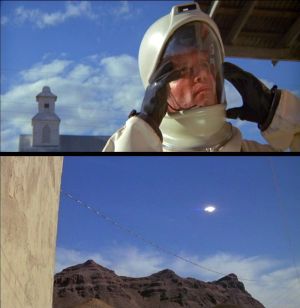
- Hall: Up there! Look.
- Stone: An Air Force jet. If we don't make it to Wildfire, he'll see the helicopter does... or shoot it down.
- Hall: Well, for Dempsey's sake, we better not slip up.
In Episode 10 (Platinum subtitles):
- Shinji: What are those?
- Ritsuko: The UN's Air Force is on standby alert.
- Ibuki: Until this mission has been completed.
- Asuka: Are they going to help us?
- Ritsuko: No, they're here to clean up.
- Ibuki: In case we fail.
- Asuka: What do you mean?
- Ritsuko: They will use N2 depth charges to destroy the Angel, and us with it.
- Asuka: That's awful!
- Open transmission
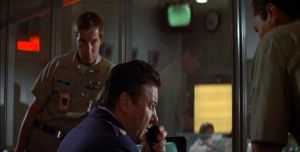
- Stone: The town is finished, contaminated beyond all...
- Major Manchek: Careful, sir. This is an open transmission.
- Stone: I'm aware of that, Manchek. Order up a 7-12.
- Major Manchek: Only the president...
- Stone: Precisely. Get on it. The town must be neutralized immediately.
In Episode 10 (Platinum subtitles):
- Misato: There's no doubt, it's an Angel. As of now, this laboratory will be completely sealed off! It's under Nerv's jurisdiction now! Any and all access to the outside world is prohibited, and all records of the events of the past six hours are classified. Request an A-17 from Commander Ikari, top priority!
- Aoba: Watch what you're saying. This is an open line.
- Misato: I know. Hurry up and switch to a scrambled line.
- Code 601
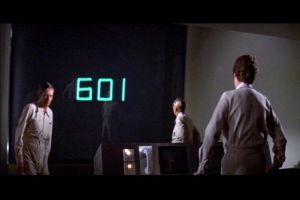
During a simulation of how the Andromeda Cell functions, an error message appears on the main computer monitor.
- Dutton: What the devil?
- Stone: 601? The computer's overloaded! Too much data coming in too fast.
In Episode 05 (Platinum subtitles):
- Misato: What the heck is this?
- Ritsuko: That's the code number for "cannot be analyzed".
- Misato: You mean, you don't know what the heck it is?
- The Shaft
Both the Wildfire facility and the geofront have a large shaft running deep below and past several levels, and the visual displays for both are very similar.
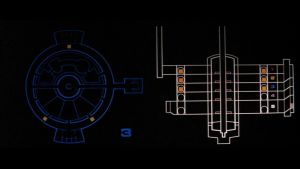
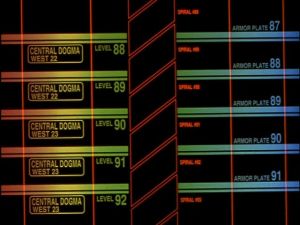
- Other visuals
As opposed to the usual octagonal, Ireul's A.T. Field projections are hexagonal in shape. Andromeda Cells, although constantly evolving, most often assume a form of a hexagonal crystal.
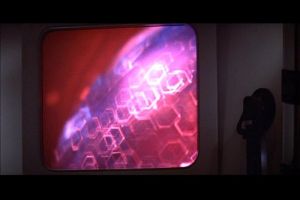
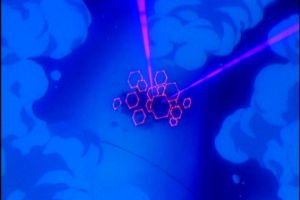
The placards in Episode 20 use the same method of counting time (black background with Nth DAY).
